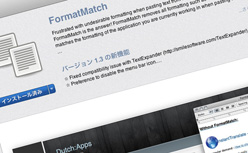

#FORMATMATCH WINDOWS WINDOWS#
Microsoft Edge makes limited use of Windows Security Zones.
#FORMATMATCH WINDOWS MANUAL#
Beyond manual administrative or user assignment of sites to Zones, other heuristics could assign sites to the Local Intranet Zone.

In managed environments, administrators can use Group Policy to assign specific sites to Zones (via "Site to Zone Assignment List" policy) and specify the settings for URLActions on a per-zone basis. Users can use the Internet Control Panel to assign specific sites to Zones and to configure the permission results for each zone. Reasonable defaults like "Automatically satisfy authentication challenges from my Intranet" means that most users never need to change any default settings. When making a page load decision, the browser maps the website to a Zone, then consults the setting for the URLAction for that Zone to decide what to do. These Security Zones are: Local Machine, Local Intranet, Trusted, Internet, and Restricted Sites. To simplify configuration for the user or admin, the legacy platform classified sites into one of five different Security Zones. Windows Security Zones are still used for a few configuration decisions. In Microsoft Edge, most per-site permissions are controlled by settings and policies expressed using a simple syntax with limited wild-card support. The URLAction, Enterprise Group Policy, and user settings in the Internet Control Panel controlled how the browser would handle each decision. For more information, see URL Action Flags. In the Internet Explorer web platform, each of these decisions was called a URLAction. The URL of the page for which the decision is made.In most cases, browser decisions are governed by the following inputs: Some, but not all, of these decisions include: whether a particular API is available, should a resource load be permitted, and should a script be allowed to run. The browser as a decision makerĪs a part of every page load, browsers make many decisions. This article describes the per-site configurations by policy and how the browser handles page loads from a site.


 0 kommentar(er)
0 kommentar(er)
